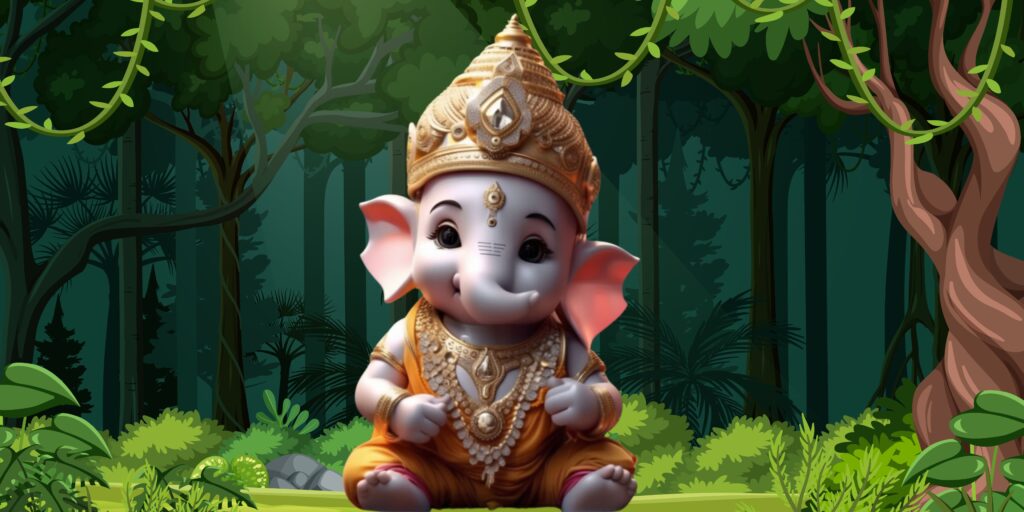The Ganesha story, one of the most beloved and widely worshipped deities in mythology, is rich with symbolism, moral lessons, and cultural significance. From his origin to his role as the remover of obstacles, Ganesha’s tale has captivated the hearts and minds of devotees for centuries. Let’s delve deeper into the intricate narrative of ganesha, exploring its various interpretations and cultural contexts.
Birth Of Ganesha
Ganesha, also known as ganapati or vinayaka and lambodar, is depicted as a deity with the head of an elephant and the body of a human. he is the son of lord shiva, the supreme deity of destruction and transformation, and goddess parvati, the divine mother. Ganpati is often portrayed as a cheerful, pot-bellied figure with multiple arms, each carrying symbolic objects such as a modak (sweet dumpling), a lotus and a broken tusk. Lord ganesha was very intelligent.
The ganesha story birth varies in different hindu texts and traditions, but one of the most popular versions is found in the puranas, ancient hindu scriptures. According to this narrative, parvati, desiring a child, created ganpati out of sandalwood paste while her husband shiva was away. She breathed life into the figure and instructed him to guard the entrance while she bathed.
When shiva returned and attempted to enter his abode, he was obstructed by the young ganesha, dutifully followed his mother’s orders. Unaware of ganesha’s identity. Shiva was infuriated by the boy’s defiance and engaged in fierce battle with him. In a moment of rage, shiva decapitated ganesha with his trident, severing the boy’s head from his body.

About of Ganpati
Upon witnessing the tragic scene, parvati was overcome with grief and anger. She demanded that shiva revive their son immediately. Realizing the gravity of his actions, shiva vowed to rectify the situation and restore ganesha’s life. He instructed his followers, the ganas (attendants), to search for the head of the first living being they encountered and bring it back to him.
The ganas embarked on their mission and soon stumbled upon an elephant. They swiftly decapitated the creature and presented its head to shiva. Moved by their devotion and determination, shiva affixed the elephant’s head onto ganesha’s lifeless body, thus resurrecting him. ganesha, now bearing the head of an elephant. Regained consciousness and emerged as a divine being imbued with immense power and wisdom. Ganesh brother’s name is karthik.

Lambodar(Vinayaka)
This transformation marked the beginning of ganesha’s journey as a revered deity and the remover of obstacles. He was bestowed with numerous titles and epithets, including vighnaharta (the one who removes obstacles), siddhidata (the bestower of success), and vinayaka (the leader of multitudes).
The symbolism embedded within ganesha’s story is profound and multi-layered. reflecting various aspects of hindu philosophy and spirituality. Firstly, ganesha;s elephant symbolizes intelligence, wisdom, foresight, attributes that are essential for navigating life’s challenges and achieving spiritual growth. The elephant, revered for eats strength and memory in indian culture, embodies the qualities of resilience and adaptability.

Moreover, ganesha’s broken tusk holds symbolic significance, representing the willingness to sacrifice one’s ego and embrace imperfection in pursuit of higher ideals. According to some interpretations, ganesha broke is tusk to inscribe the epic mahabharata when sage vyasa sought his assistance. This act exemplifies his role as a patron of learning and literature.
Furthermore, ganesha’s status as the son of shiva and parvati illustrates the concept of divine duality and harmony within the hindu pantheon. While shiva embodies the forces of destruction and transformation, parvati represents nurturing and creative energy. Ganesha, born out of their union, embodies the synthesis of opposing forces, symbolizing balance and equilibrium in the universe.

Worship Of Ganpati
Ganesha’s association with obstacles and their removal is central to his worship and mythology. As the lord of beginnings and transitions, he is invoked at the onset of new ventures, ceremonies, and endeavors to seek his blessings and guidance. Devotees offer prayers and offerings to Ganpati to seek his assistance in overcoming obstacles and achieving success in their endeavors.
In addition to his roles as a remover of obstacles, Ganesha is also revered as a guardian and protector, safeguarding devotees from harm and adversity. His benevolent preseence is believed to bring prosperity, good fortune, and auspiciousness to devotee’s lives.
The festival of ganesh chaturthi, celebrated with great fervor and enthusiasm across india, is dedicated to the worship of ganpati. During this ten-day festival, elaborate processions, rituals, and ceremonies are held to honor the deity. Artisans craft intricately designed idols of ganpati, which are installed in homes and community pandals (temporary structures) for worship.

Ganesh Chaturthi
The culmination of ganesh chaturthi is marked by the immersion of ganesha idols in rivers, lakes or the sea, symbolizing his return to his celestial abode. This ritual, known as visarjan, is accompanied by chantig, singing, and dancing as devotees bid farewell to their beloved deity.
Beyond its religious significance, the ganesha story of carries profound moral lessons and philosophical insights that resonate with people of all backgrounds. It teaches the importance of humility, forgiveness, and redemption, reminding us that even in moments of conflict and adversity, there is always the possibility of renewal and transformation. ganesha’s wifes name riddhi and siddi.
Moreover, ganesha’s inclusive and compassionate nature transcends cultural a d religious boundarieus, making him a beloved figure not only in hinduism but also in various other spiritual traditions. His universal appeal as a symbol of wisdom, prosperity, and protection has led to his veneration by millions of people around the world, regardless of their faith or beliefs.
In conclusion, the ganesha story is continues to inspire and uplift generations of devotees with its profound teachings and enduring symbolism. Ganpati story also called gajanan and everyone should say ganpati bappa moriya.
